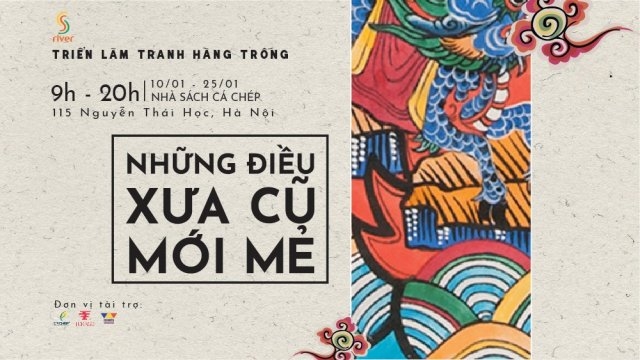Hang Trong folk paintings exhibited in Hanoi
An exhibition on Hang Trong folk paintings will take place at the Ca Chep Bookstore at 115 Nguyen Thai Hoc Street in Hanoi’s Ba Dinh district from January 10 to 25.

With the theme “The New Classics”, the exhibition is a part of a project by S River, a group of young people passionate about Hang Trong folk paintings and keen to preserve traditional values.
It aims to bring young people closer to the art of Hang Trong folk paintings and show visitors to the exhibition how the folk art can be applied in modern life.
The exhibition includes three parts: a space for iconic Hang Trong folk paintings on three topics: worshipping for the Lunar New Year (Tet), patterns and creative designs that may be applied in contemporary design, and products with ancient Hang Trong patterns and colors. There will also be a talkshow by artist and art researcher Phan Ngoc Khue and designer Trinh Thu Trang on January 13.
Hang Trong folk painting is a unique style representing the aesthetic, spiritual, and religious values of the people of ancient Hanoi. The style, however, is in danger of being lost and is primarily kept by museums or art collectors.
The first Hang Trong paintings appeared in the 17th century in the heart of the capital, from Hang Trong to Hang Quat Streets, which was a familiar area for arts and crafts.
The origin of Hang Trong paintings is believed to stem from religious paintings, with typical features including slight lines, meticulous and sophisticated details, or bright and animated colors, according to researcher Mr. Khue. The paintings also tell stories of the beliefs and hopes of Vietnamese, in particular reflected in worshipping paintings, one of its two famous types and showing the influence of Buddhism and Confucianism on daily life and culture.
Displayed not only at places of worship such as temples and pagodas but also in the family home, worship paintings are diverse but feature familiar figures such as Buddha, Bodhisattva, and the Fortune God, as well as deities of power and luck, such as the tiger and the carp. All show the respect of the people for the mysterious and sacred deities, in the hope they will protect them from evil and bring them good fortune.
Hang Trong paintings also depict daily life, showing traditional habits and customs expressing joy, prosperity and happiness, such as colorful flowers in spring, countryside markets, classic paintings of Tung, Cuc, Truc, Mai (the four prosperity trees: pine, daisy, bamboo and apricot blossoms), To nu (Young Lady), folk stories and games like Thay do Coc (the toad scholar), Bit mat bat de (Blindman’s bluff), and Rong ran len may (Dragon-Snake). The artworks belong to another familiar type of Hang Trong art, known as Tet paintings. After a year, people change their old paintings with new ones to welcome in the new year with hopes of joy and fortune.

With the theme “The New Classics”, the exhibition is a part of a project by S River, a group of young people passionate about Hang Trong folk paintings and keen to preserve traditional values.
It aims to bring young people closer to the art of Hang Trong folk paintings and show visitors to the exhibition how the folk art can be applied in modern life.
The exhibition includes three parts: a space for iconic Hang Trong folk paintings on three topics: worshipping for the Lunar New Year (Tet), patterns and creative designs that may be applied in contemporary design, and products with ancient Hang Trong patterns and colors. There will also be a talkshow by artist and art researcher Phan Ngoc Khue and designer Trinh Thu Trang on January 13.
Hang Trong folk painting is a unique style representing the aesthetic, spiritual, and religious values of the people of ancient Hanoi. The style, however, is in danger of being lost and is primarily kept by museums or art collectors.
The first Hang Trong paintings appeared in the 17th century in the heart of the capital, from Hang Trong to Hang Quat Streets, which was a familiar area for arts and crafts.
The origin of Hang Trong paintings is believed to stem from religious paintings, with typical features including slight lines, meticulous and sophisticated details, or bright and animated colors, according to researcher Mr. Khue. The paintings also tell stories of the beliefs and hopes of Vietnamese, in particular reflected in worshipping paintings, one of its two famous types and showing the influence of Buddhism and Confucianism on daily life and culture.
Displayed not only at places of worship such as temples and pagodas but also in the family home, worship paintings are diverse but feature familiar figures such as Buddha, Bodhisattva, and the Fortune God, as well as deities of power and luck, such as the tiger and the carp. All show the respect of the people for the mysterious and sacred deities, in the hope they will protect them from evil and bring them good fortune.
Hang Trong paintings also depict daily life, showing traditional habits and customs expressing joy, prosperity and happiness, such as colorful flowers in spring, countryside markets, classic paintings of Tung, Cuc, Truc, Mai (the four prosperity trees: pine, daisy, bamboo and apricot blossoms), To nu (Young Lady), folk stories and games like Thay do Coc (the toad scholar), Bit mat bat de (Blindman’s bluff), and Rong ran len may (Dragon-Snake). The artworks belong to another familiar type of Hang Trong art, known as Tet paintings. After a year, people change their old paintings with new ones to welcome in the new year with hopes of joy and fortune.

Leave your comment on this story